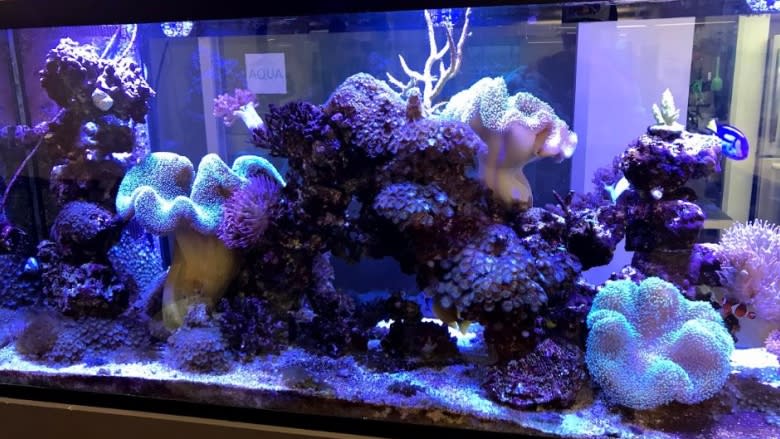Gatineau family's plight highlights risks of toxic coral
A family in Gatineau is struggling to find help after they say they came into contact with a dangerous toxin — and the culprit may have been in their saltwater aquarium.
Jason Laframboise said he bought the 1,100-litre aquarium from a local business on Sunday and brought it home to clean. He said he removed the coral from the aquarium and placed it in buckets during that process.
But while setting up the aquarium in the house, the family began to feel ill. It started with sneezing, Laframboise said, progressing to chest pain, difficulty breathing and nausea.
He and six other members of his family, including his pregnant wife, ended up in quarantine at Montfort Hospital.
Several people who spoke to CBC News said the toxin found in saltwater aquariums comes from a certain type of common coral, called a zoanthid.
These types of coral can contain palytoxin, which can be harmful when ingested or inhaled, said Joe McLaughlin, an epidemiologist with Alaska Public Health.
Any type of rough handling, such as dropping or scrubbing, can potentially cause the animals to release the toxin into the air.
Though cases of poisoning are rare, it's important for aquarium hobbyists to take precautions, McLaughlin said. Here's what you need to know.
A coral conundrum
Zoanthids are pretty common among aquarium hobbyists, said Marcello Portillo, who owns a corar and aquarium store in Toronto.
"In most reef aquariums, you'd find this kind of coral," he said. "A lot of people keep it because it's inexpensive and they're colourful and they're easy to keep."
However, they're still "one of the most toxic things in the aquarium hobby," he said.
According to the Canadian Food Inspection Agency, there are no specific requirements that have to be met when importing coral. Likewise, there are no restrictions on who can buy or sell it, Portillo said — and he doesn't think there should be.
"It's more or less up to the hobbyist to do research," he said. "It's the same as buying a venomous snake or spider. It's an animal and it's alive and it wants to protect itself."
With proper caution, zoanthids can be handled safely. Portillo grows zoanthids in his store and said he handles them often and without incident.
According to McLaughlin, aquarium owners should be aware of which corals contain the toxin and act accordingly.
In a written statement, he said hobbyists should be "careful to minimize the amount of time that zoanthid corals spend out of the water while cleaning," and avoid scrubbing them or introducing them to hot water.
Other precautions include wearing gloves and eye protection, he said. After cleaning an aquarium, he said owners should wipe down floors, furniture and external aquarium glass with a diluted bleach solution.
Similar cases seen elsewhere
Between 2012 and 2014, 10 people in Anchorage, Alaska, reported symptoms similar to those suffered by the Laframboise family after cleaning or handling coral.
In August 2014 a middle-aged man went to the emergency room complaining of a metallic taste in his mouth, a cough, fever and weakness after the "introduction of live zoanthid coral into his home aquarium," according to a U.S. Centers for Disease Control and Prevention (CDC) report.
The man told doctors a relative had transferred the coral from plastic containers to his aquarium the previous day. Both his roommates had similar symptoms.
The incident sparked an epidemiologic investigation by Alaska Public Health. According to the CDC report, investigators soon found seven other cases of palytoxin-related illness, including five employees at a marine aquarium store and two other people who had cleaned their aquarium at home.
According to a study done in 2017, there were 171 cases of exposure to palytoxin reported to the U.S. National Poison Data System between 2000 and 2014.
Though many of those cases involved minor symptoms, 10 required admittance to an intensive care unit, McLaughlin said.
What to do if it happens to you
If you have a saltwater aquarium, it's important to know which, if any, of your corals might contain the toxin, and be aware of the symptoms that might come with exposure.
Those can include a bitter metallic or salty taste, nausea, vomiting, weakness, shortness of breath, coughing, joint and muscle pain, fever, difficulty swallowing and dizziness.
Anyone with those symptoms who thinks they may have been exposed to the toxin should seek medical attention, McLaughlin said.





